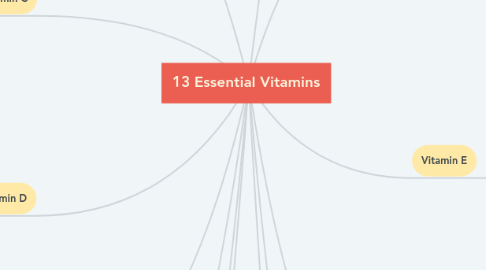
1. Vitamin B12
1.1. Like the other B vitamins, it's important for metabolism and helps form red blood cells and maintain the central nervous system.
1.2. How to get it
1.2.1. Milk
1.2.2. Cheese
1.2.3. Yogurt
1.2.4. Animal Liver and Kidneys
1.2.5. Beef
1.2.6. Tuna
2. Vitamin C
2.1. Also called ascorbic acid, it's an antioxidant that promotes healthy teeth and gums, as well as wound healing. It helps the body absorb iron and maintain healthy tissue.
2.2. How to get it
2.2.1. Vegetables: kale, broccoli, brussels sprouts, cauliflower, sweet potato, asparagus, peppers
2.2.2. Fruits: kiwi, oranges, lemons, Pineapple, mango, avocado
3. Vitamin D
3.1. It helps the body absorb calcium, which you need for the normal development and maintenance of healthy teeth and bones.
3.2. How to get it
3.2.1. fatty fish (salmon, herring, mackerel)
3.2.2. fish liver oils
3.2.3. Egg, yolk, cooked
3.2.4. Rice, oat, almond beverage, fortified with Vitamin D
4. Vitamin K
4.1. It helps the blood coagulate, and may be important for bone health.
4.2. How to get it
4.2.1. cabbage, cauliflower, dark-green veggies (broccoli, asparagus, Brussel sprouts), dark leafy greens (spinach, kale, collards)
4.2.2. fish, liver, beef, eggs
5. Niacin (Vitamin B3)
5.1. It's a B vitamin that helps maintain healthy skin and nerves. It also has cholesterol-lowering effects at higher doses.
5.2. How to get it
5.2.1. Turkey and Chicken breast
5.2.2. Peanuts
5.2.3. Mushroom
5.2.4. Liver
5.2.5. Tuna
5.2.6. Beef
5.2.7. Avocado
6. Pantothenic Acid (Vitamin B5)
6.1. It's essential for the metabolism of food and plays a role in the production of hormones and cholesterol.
6.2. How to get it
6.2.1. avocado, kale, broccoli, lentils, mushrooms, sweet potatoes
6.2.2. eggs
6.2.3. organ meats
7. Thiamine (Vitamin B1)
7.1. It helps your cells change carbohydrates into energy.
7.2. How to get it
7.2.1. nuts
7.2.2. fish
7.2.3. beans
7.2.4. asparagus
8. Vitamin A
8.1. It helps to form and maintain healthy teeth, bones, soft tissue, mucous membranes, and skin.
8.2. How to get it
8.2.1. dark leafy greens
8.2.2. dark-colored fruits
8.2.3. egg yolks
8.2.4. fortified dairy products (some cheese, yogurts, butters, and creams — check the label)
8.2.5. liver, fish, beef.
9. Vitamin B6
9.1. Also called pyridoxine, it helps form red blood cells and maintain brain function.
9.2. How to get it
9.2.1. avocado
9.2.2. bananas
9.2.3. Chickpeas
9.2.4. Tuna
9.2.5. Salmon
9.2.6. Turkey Breast
9.2.7. Beef
9.2.8. Pistachios, Sunflower Seeds, Sesame Seeds
10. Biotin (vitamin B7)
10.1. It's essential for the metabolism of proteins and carbohydrates, and in the production of hormones and cholesterol.
10.2. How to get it
10.2.1. organ meats (especially liver and kidney)
10.2.2. Egg yolk
10.2.3. brewer's yeast and nutritional yeast
10.2.4. Almonds, peanuts, walnuts, and pecans
10.2.5. Salmon
10.2.6. Milk, cheese, and yogurt
10.2.7. Avocados, Sweet potatoes, Cauliflower
11. Folate (vitamin B12)
11.1. It works with vitamin B12 to help form red blood cells. It is needed for the production of DNA, which controls tissue growth and cell function.
11.2. How to get it
11.2.1. asparagus, broccoli, beets
11.2.2. dried beans (pinto, lentils, navy, kidney, lima)
11.2.3. leafy greens (spinach, romaine)
11.2.4. peanut butter
11.2.5. brewer's yeast
12. Riboflavin (Vitamin B2)
12.1. It works with the other B vitamins to promote growth and the production of red blood cells.
12.2. How to get it
12.2.1. Beef liver
12.2.2. Milk, Natural yogurt
12.2.3. Mushrooms
12.2.4. Spinach
12.2.5. Almonds
12.2.6. Sun-dried tomatoes
13. Vitamin E
13.1. It's an antioxidant also known as tocopherol that helps the body form red blood cells and use vitamin K.
13.2. How to get it
13.2.1. Vegetables: spinach, tomatoes, peppers, avocado,
13.2.2. Egg, cooked
13.2.3. Tuna
13.2.4. Almonds, Sunflower seeds, Hazelnuts, Peanuts, Peanut butter, almond butter
